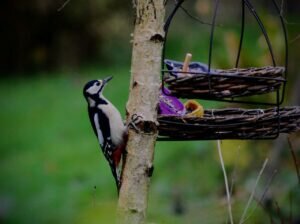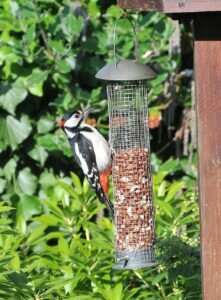Lesser spotted woodpeckers are divided into eleven different subspecies. They cover a large territory that stretches from Europe to Northern China, passing via central and southern Russia. This profile is just for the UK-based subspecies of Dryobates minor comminutus (still referred to as Dendrocopos minor by certain authorities). The British Lesser Spotted Woodpecker is another name for this bird.
Other names: British Lesser Spotted Woodpecker
Family: Woodpeckers
Length: 14cm to 15cm
Wingspan: 25cm to 27cm
Weight: 17g to 25g
What is the appearance of a Lesser Spotted Woodpecker?
This is the smallest and rarest of the UK’s resident woodpeckers, with a size similar to that of a tree sparrow. The mature male may be identified by his conspicuous ruby red hat with black edges and black upper body with broad white barring. The cheeks are black, while the face, forehead, lores (the region between the eyes and the nostrils), throat, and underparts are off white. The flanks are white with narrow black streaks, and the flight feathers are black with white barring. Black wing coverts with white speckled tips. The short and strong bill, as well as the legs, are grey. The toes are unusually positioned on the foot, with two pointing forward and two pointing directly behind.
Lesser potted Woodpecker was eating his lunch when I came across him and grabbed this shot! At a local park
What is the call of the Lesser Spotted Woodpecker?
Both males and females vocalize, especially in the spring, when a staccato and repeating ‘pee – pee – pee’ sound may be heard. A weaker ‘chig’ sound is also occasionally heard, usually from up in the tree tops. Although they may be heard tapping (drumming) on trees with their bills, they are not as noisy as the other two resident Woodpecker species present in the British Isles.
The Lesser Spotted Woodpecker eats a variety of foods.
The beak of lesser spotted woodpeckers are built to efficiently retrieve insects and insect larvae from beneath tree bark, which are the majority of their diet. They will also eat spiders, caterpillars, grubs, and beetles from plant stems and shrubs, as well as berries and fruits on rare occasions.
Distribution
Most counties in the southeast and southwest, as well as South Wales, are confined to England from the Midlands south. Limited populations can also be found in isolated locations in the north of England, particularly in Lancashire and Yorkshire. The British lesser spotted woodpecker is a critically endangered species that is classified as Red in the UK Birds of Conservation Concern 4 list (BoCC4).
Signs to Look For and How to Spot Them
These are mostly solitary and sedentary birds that spend the most of their time up in the forest canopy, making them difficult to observe. They prefer unmanaged open deciduous woods with dead and rotting trunks and branches, although they will also visit orchards, parks, and gardens, where they will occasionally feed from bird tables. The patterning and barring on their backs, in particular, is not as sharp as on other woodpeckers, resulting in a little ‘blurred’ appearance.
Breeding
Each year, between late April and June, one clutch of 4–6 white coloured eggs is produced and incubated by both parents for up to twelve days. Fledging usually happens three weeks later, and parental support usually lasts another one to two weeks. Both adult birds scrape out a burrow in a rotten or decaying limb high above the ground to build their nests, which are unlined save for excavated wood dust.

What is the life expectancy of Lesser Spotted Woodpeckers?
Adult lesser spotted woodpeckers have a life expectancy of five to 10 years.
Read Also
Baby Toucan – Fun Facts with Pictures
Types of Hummingbirds in New Jersey




